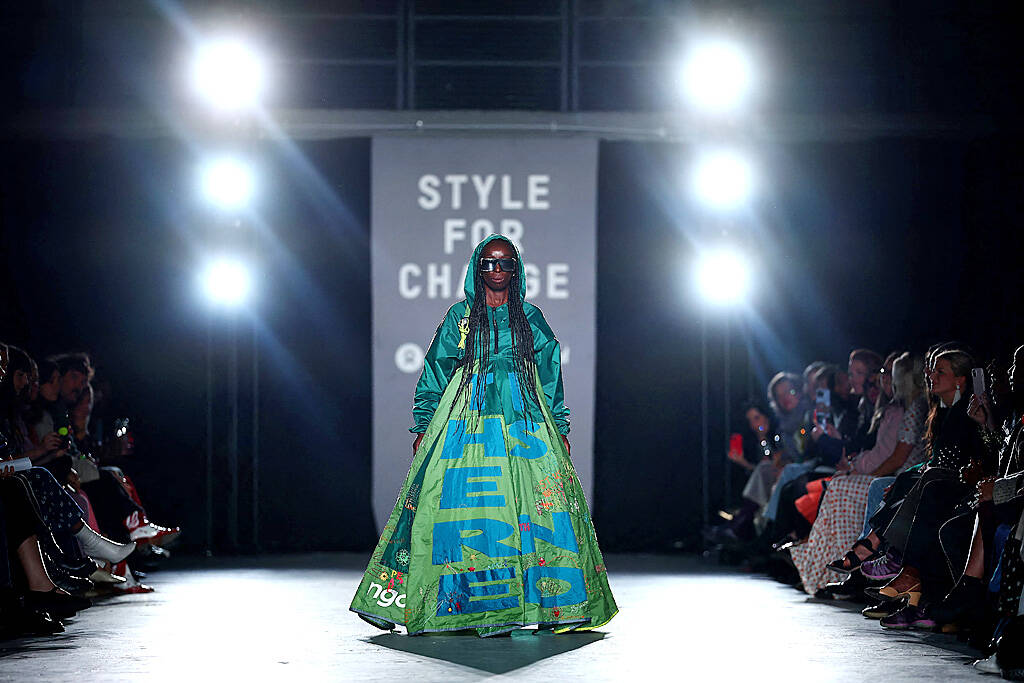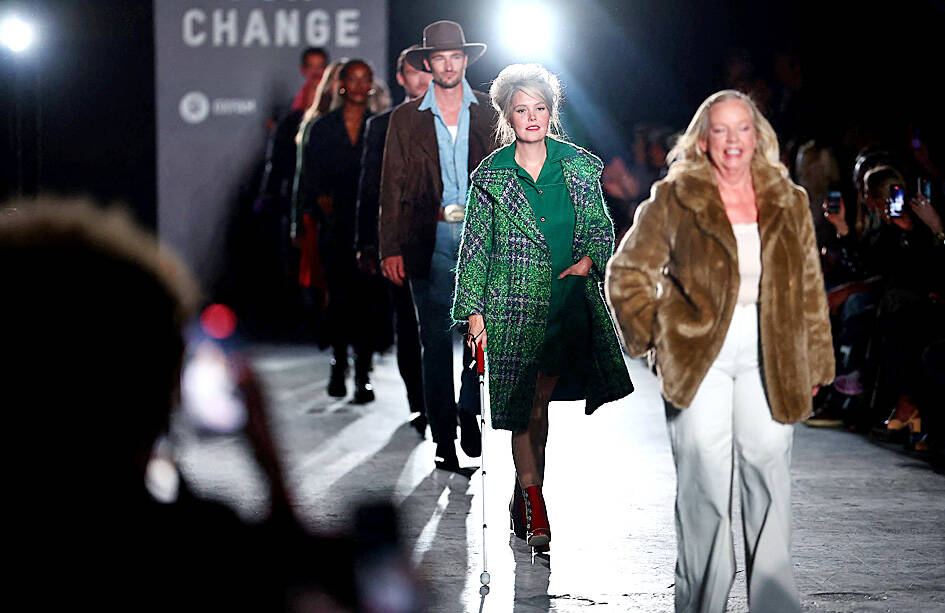In an industrial underground space in central London, models in contrasting period dresses and playful streetwear strutted down a brightly lit London Fashion Week runway.
Unlike most other shows, all the floral dresses, trending workwear and double-denim outfits were secondhand at the event by charity Oxfam and online used clothes retailer Vinted’s “Style for Change.”
Bay Garnett, a sustainable fashion pioneer who picked out the pieces from Oxfam’s warehouses, called the runway “really exciting.”

Photo: AFP
“When we first did this show eight years ago, it was really not like this,” Garnett said backstage, noting the stream of enthusiastic attendees.
Despite the excitement surrounding the Oxfam show alongside another “pre-loved” runway by online auction site eBay Inc, British fashion is struggling with sustainability.
About 44 percent of all British companies overall have put in place a structured climate action plan, according to insurance company Aviva PLC’s “Climate-Ready Index.”

Photo: AFP
By contrast, the fashion world is lagging sorely behind, a situation the Collective Fashion Justice (CFJ) charity said was “an embarrassment.”
A recent CFJ report found that just seven of the 206 members of the British Fashion Council (BFC), which organizes London Fashion Week, had set out targets to reduce their carbon emissions.
Only five of them — or less than 2.5 percent — had goals aligned with the 2016 Paris Agreement to cut global warming, CFJ said.
The UK is the third largest footwear and clothing market in the world, after China and the US, an analysis by the FashionUnited platform showed.
A report released in 2018 by sustainability consultancy Quantis said the sectors account for about 8 percent of planet-heating greenhouse gas emissions.
Luxury fashion giant Burberry Group PLC — a London Fashion Week veteran — is one of the handful of brands publishing scientific targets.
Known for its tartan branding, the fashion house recently raised its emission reduction goals and hopes to be carbon neutral by 2040.
However, BFC chief executive Caroline Rush said that was not enough.
“To set carbon reduction targets, you need a team to be able to measure your targets, understand how to reduce them and then report on them,” she said. “For a small business that’s quite a challenge.”
To help, the BFC has about 50 businesses that would go through its “low carbon transition” program for designers.
Ideally, the program should be extended to help brands monitor and report their carbon reduction plans, advocates said.
Copenhagen Fashion Week has taken its own step to require all brands involved to meet a series of environmental goals.
In the US, reform could come with a “Fashion Act” under consideration by New York authorities, which would legally require businesses to cut emissions and take into account those of their entire supply chains.
“I think a lot of the issue is [that] the fashion industry can try to handball its problems to other industries,” CFJ director Emma Hakansson said.
For example, while there are many discussions on the climate impact of the meat industry, there was not the same pressure on producers of such materials as leather, wool and cashmere, she said.
Yet the latter “are coming from the same supply chains,” which use large quantities of water and emit methane, she added.
There are a number of solutions to make fashion “greener,” some of which would be on display at London Fashion Week, which started on Thursday and ends on Tuesday.
Taiwanese designer Ray Chu (朱柏諺) has created a vegan leather made using recycled tea leaves, while Romanian designer Ancuta Sarca uses recycled materials in her footwear collections.
However, such innovations could struggle to keep up with the scale of emissions and textile waste.
About 300 tonnes of clothes are thrown away every year in the UK, a 2020 British parliament report showed.
Since then, the popularity of fast fashion brands such as Hennes & Mauritz AB’s H&M and Inditex SA’s Zara, and ultra-fast fashion brands like Shein (希音) and PDD Holdings Inc’s (拼多多控股) Temu, has only grown.
Such brands sell cheaply made, mass-manufactured clothes at breakneck speeds, only for them to fall apart or be discarded after being worn a few times.
While many brands are turning to recycled materials, or offering clothing repair or rental services, the long-term solution seems to be to “slow down our habits of consumption in general,” Hakansson said.
To help with this, people could work toward “cultivating a sense of personal style,” she said.
“If you don’t know what you as an individual like, then you’re much more likely to follow these micro trends that are being really pushed on us very hard,” she added.
With greater awareness of the challenges posed by climate change, shopping second-hand has become more popularity, Garnett said.
“The kids have basically got the idea that ... secondhand — it’s a cool way to shop. By finding your own style, a one-off piece, it [becomes] like a style choice,” she said.

‘SWASTICAR’: Tesla CEO Elon Musk’s close association with Donald Trump has prompted opponents to brand him a ‘Nazi’ and resulted in a dramatic drop in sales Demonstrators descended on Tesla Inc dealerships across the US, and in Europe and Canada on Saturday to protest company chief Elon Musk, who has amassed extraordinary power as a top adviser to US President Donald Trump. Waving signs with messages such as “Musk is stealing our money” and “Reclaim our country,” the protests largely took place peacefully following fiery episodes of vandalism on Tesla vehicles, dealerships and other facilities in recent weeks that US officials have denounced as terrorism. Hundreds rallied on Saturday outside the Tesla dealership in Manhattan. Some blasted Musk, the world’s richest man, while others demanded the shuttering of his

Taiwan’s official purchasing managers’ index (PMI) last month rose 0.2 percentage points to 54.2, in a second consecutive month of expansion, thanks to front-loading demand intended to avoid potential US tariff hikes, the Chung-Hua Institution for Economic Research (CIER, 中華經濟研究院) said yesterday. While short-term demand appeared robust, uncertainties rose due to US President Donald Trump’s unpredictable trade policy, CIER president Lien Hsien-ming (連賢明) told a news conference in Taipei. Taiwan’s economy this year would be characterized by high-level fluctuations and the volatility would be wilder than most expect, Lien said Demand for electronics, particularly semiconductors, continues to benefit from US technology giants’ effort

ADVERSARIES: The new list includes 11 entities in China and one in Taiwan, which is a local branch of Chinese cloud computing firm Inspur Group The US added dozens of entities to a trade blacklist on Tuesday, the US Department of Commerce said, in part to disrupt Beijing’s artificial intelligence (AI) and advanced computing capabilities. The action affects 80 entities from countries including China, the United Arab Emirates and Iran, with the commerce department citing their “activities contrary to US national security and foreign policy.” Those added to the “entity list” are restricted from obtaining US items and technologies without government authorization. “We will not allow adversaries to exploit American technology to bolster their own militaries and threaten American lives,” US Secretary of Commerce Howard Lutnick said. The entities

TIGHT-LIPPED: UMC said it had no merger plans at the moment, after Nikkei Asia reported that the firm and GlobalFoundries were considering restarting merger talks United Microelectronics Corp (UMC, 聯電), the world’s No. 4 contract chipmaker, yesterday launched a new US$5 billion 12-inch chip factory in Singapore as part of its latest effort to diversify its manufacturing footprint amid growing geopolitical risks. The new factory, adjacent to UMC’s existing Singapore fab in the Pasir Res Wafer Fab Park, is scheduled to enter volume production next year, utilizing mature 22-nanometer and 28-nanometer process technologies, UMC said in a statement. The company plans to invest US$5 billion during the first phase of the new fab, which would have an installed capacity of 30,000 12-inch wafers per month, it said. The